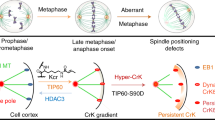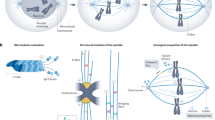Abstract
Mitotic spindle positioning by cortical pulling forces1 defines the cell division axis and location2, which is critical for proper cell division and development3. Although recent work has identified developmental and extrinsic cues that regulate spindle orientation4,5,6, the contribution of intrinsic signals to spindle positioning and orientation remains unclear. Here, we demonstrate that cortical force generation in human cells is controlled by distinct spindle-pole- and chromosome-derived signals that regulate cytoplasmic dynein localization. First, dynein exhibits a dynamic asymmetric cortical localization that is negatively regulated by spindle-pole proximity, resulting in spindle oscillations to centre the spindle within the cell. We find that this signal comprises the spindle-pole-localized polo-like kinase (Plk1), which regulates dynein localization by controlling the interaction between dynein–dynactin and its upstream cortical targeting factors NuMA and LGN. Second, a chromosome-derived RanGTP gradient restricts the localization of NuMA–LGN to the lateral cell cortex to define and maintain the spindle orientation axis. RanGTP acts in part through the nuclear localization sequence of NuMA to locally alter the ability of NuMA–LGN to associate with the cell cortex in the vicinity of chromosomes. We propose that these chromosome- and spindle-pole-derived gradients generate an intrinsic code to control spindle position and orientation.
This is a preview of subscription content, access via your institution
Access options
Subscribe to this journal
Receive 12 print issues and online access
$209.00 per year
only $17.42 per issue
Buy this article
- Purchase on Springer Link
- Instant access to full article PDF
Prices may be subject to local taxes which are calculated during checkout




Similar content being viewed by others
References
Grill, S. W. & Hyman, A. A. Spindle positioning by cortical pulling forces. Dev. Cell 8, 461–465 (2005).
Glotzer, M. The mechanism and control of cytokinesis. Curr. Opin. Cell Biol. 9, 815–823 (1997).
Gonczy, P. Mechanisms of asymmetric cell division: flies and worms pave the way. Nat. Rev. Mol. Cell Biol. 9, 355–366 (2008).
Thery, M. et al. The extracellular matrix guides the orientation of the cell division axis. Nat. Cell Biol. 7, 947–953 (2005).
Toyoshima, F. & Nishida, E. Integrin-mediated adhesion orients the spindle parallel to the substratum in an EB1- and myosin X-dependent manner. EMBO J. 26, 1487–1498 (2007).
Siller, K. H. & Doe, C. Q. Spindle orientation during asymmetric cell division. Nat. Cell Biol. 11, 365–374 (2009).
Kardon, J. R. & Vale, R. D. Regulators of the cytoplasmic dynein motor. Nat. Rev. Mol. Cell Biol. 10, 854–865 (2009).
Woodard, G. E. et al. Ric-8A and Gi α recruit LGN, NuMA, and dynein to the cell cortex to help orient the mitotic spindle. Mol. Cell Biol. 30, 3519–3530 (2010).
Du, Q. & Macara, I. G. Mammalian Pins is a conformational switch that links NuMA to heterotrimeric G proteins. Cell 119, 503–516 (2004).
Sumara, I. et al. Roles of polo-like kinase 1 in the assembly of functional mitotic spindles. Curr. Biol. 14, 1712–1722 (2004).
Bayliss, R., Sardon, T., Vernos, I. & Conti, E. Structural basis of Aurora-A activation by TPX2 at the mitotic spindle. Mol. Cell 12, 851–862 (2003).
Lampson, M. A. & Cheeseman, I. M. Sensing centromere tension: Aurora B and the regulation of kinetochore function. Trends Cell Biol. 21, 133–140 (2011).
Kalab, P., Weis, K. & Heald, R. Visualization of a Ran–GTP gradient in interphase and mitotic Xenopus egg extracts. Science 295, 2452–2456 (2002).
Kalab, P. & Heald, R. The RanGTP gradient—a GPS for the mitotic spindle. J. Cell Sci. 121, 1577–1586 (2008).
Kornbluth, S., Dasso, M. & Newport, J. Evidence for a dual role for TC4 protein in regulating nuclear structure and cell cycle progression. J. Cell Biol. 125, 705–719 (1994).
Nishitani, H. et al. Loss of RCC1, a nuclear DNA-binding protein, uncouples the completion of DNA replication from the activation of cdc2 protein kinase and mitosis. EMBO J. 10, 1555–1564 (1991).
Wiese, C. et al. Role of importin- β in coupling Ran to downstream targets in microtubule assembly. Science 291, 653–656 (2001).
Nachury, M. V. et al. Importin β is a mitotic target of the small GTPase Ran in spindle assembly. Cell 104, 95–106 (2001).
Wee, B., Johnston, C. A., Prehoda, K. E. & Doe, C. Q. Canoe binds RanGTP to promote PinsTPR/Mud-mediated spindle orientation. J. Cell Biol. 195, 369–376 (2011).
Fink, J. et al. External forces control mitotic spindle positioning. Nat. Cell Biol. 13, 771–778 (2011).
Knoblich, J. A. Asymmetric cell division: recent developments and their implications for tumour biology. Nat. Rev. Mol. Cell Biol. 11, 849–860 (2010).
Kline, S. L., Cheeseman, I. M., Hori, T., Fukagawa, T. & Desai, A. The human Mis12 complex is required for kinetochore assembly and proper chromosome segregation. J. Cell Biol. 173, 9–17 (2006).
Cheeseman, I. M. et al. A conserved protein network controls assembly of the outer kinetochore and its ability to sustain tension. Genes Dev. 18, 2255–2268 (2004).
Schmidt, J. C. et al. Aurora B kinase controls the targeting of the Astrin-SKAP complex to bioriented kinetochores. J. Cell Biol. 191, 269–280 (2010).
Hutchins, J. R. et al. Systematic analysis of human protein complexes identifies chromosome segregation proteins. Science 328, 593–599 (2010).
Cheeseman, I. M. & Desai, A. A combined approach for the localization and tandem affinity purification of protein complexes from metazoans. Sci. STKE 2005, pl1 (2005).
Washburn, M. P., Wolters, D. & Yates, J. R. 3rd Large-scale analysis of the yeast proteome by multidimensional protein identification technology. Nat. Biotechnol. 19, 242–247 (2001).
Weis, K., Dingwall, C. & Lamond, A. I. Characterization of the nuclear protein import mechanism using Ran mutants with altered nucleotide binding specificities. EMBO J. 15, 7120–7128 (1996).
Acknowledgements
We thank P. Meraldi, D. Pellman, D. Yarar, K. Ribbeck and members of the Cheeseman and Hochwagen laboratories for discussions and critical reading of the manuscript, and T. DiCesare for help with generating the movie. We also thank D. Compton, T. Hyman-Mitocheck, C. Basilico and A. C. Groen for reagents. This work was supported by awards to I.M.C. from the Massachusetts Life Sciences Center, the Searle Scholars Program and the Human Frontiers Science Foundation, a grant from the National Institute of General Medical Sciences (GM088313) and a Research Scholar Grant (121776) from the American Cancer Society. I.M.C. is a Thomas D. and Virginia W. Cabot Career Development Professor of Biology. T.K. is supported by a long-term fellowship of the Human Frontiers Science Program.
Author information
Authors and Affiliations
Contributions
T.K. and I.M.C. designed the experiments. T.K. carried out all of the experiments. I.M.C. assisted with some experiments including protein purification and mass spectrometry. T.K. and I.M.C. analysed the data and wrote the manuscript.
Corresponding author
Ethics declarations
Competing interests
The authors declare no competing financial interests.
Supplementary information
Supplementary Information
Supplementary Information (PDF 1177 kb)
Supplementary Movie 1
Supplementary Information (MOV 3289 kb)
Rights and permissions
About this article
Cite this article
Kiyomitsu, T., Cheeseman, I. Chromosome- and spindle-pole-derived signals generate an intrinsic code for spindle position and orientation. Nat Cell Biol 14, 311–317 (2012). https://doi.org/10.1038/ncb2440
Received:
Accepted:
Published:
Issue Date:
DOI: https://doi.org/10.1038/ncb2440
This article is cited by
-
Laser ablation and fluid flows reveal the mechanism behind spindle and centrosome positioning
Nature Physics (2024)
-
Annexin A1 is a polarity cue that directs mitotic spindle orientation during mammalian epithelial morphogenesis
Nature Communications (2023)
-
B-type Plexins promote the GTPase activity of Ran to affect androgen receptor nuclear translocation in prostate cancer
Cancer Gene Therapy (2023)
-
Systems-level analyses of protein-protein interaction network dysfunctions via epichaperomics identify cancer-specific mechanisms of stress adaptation
Nature Communications (2023)
-
AMBRA1 phosphorylation by CDK1 and PLK1 regulates mitotic spindle orientation
Cellular and Molecular Life Sciences (2023)



